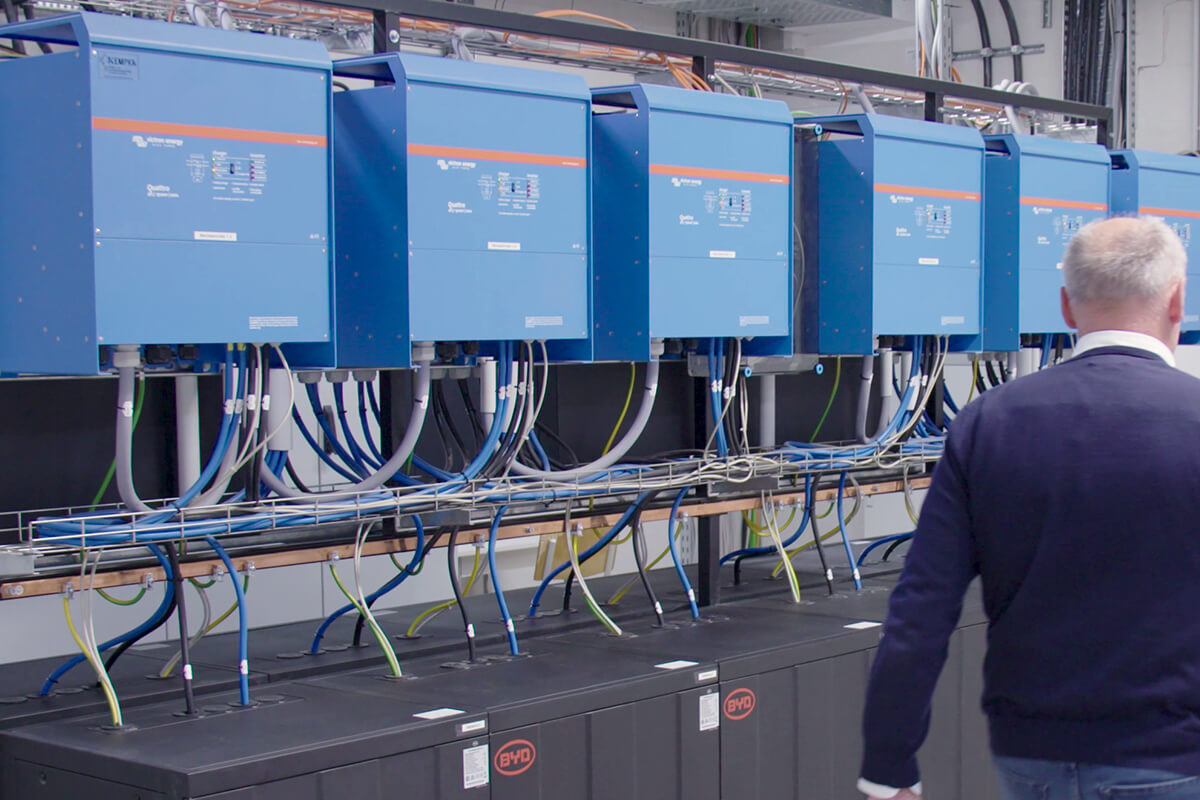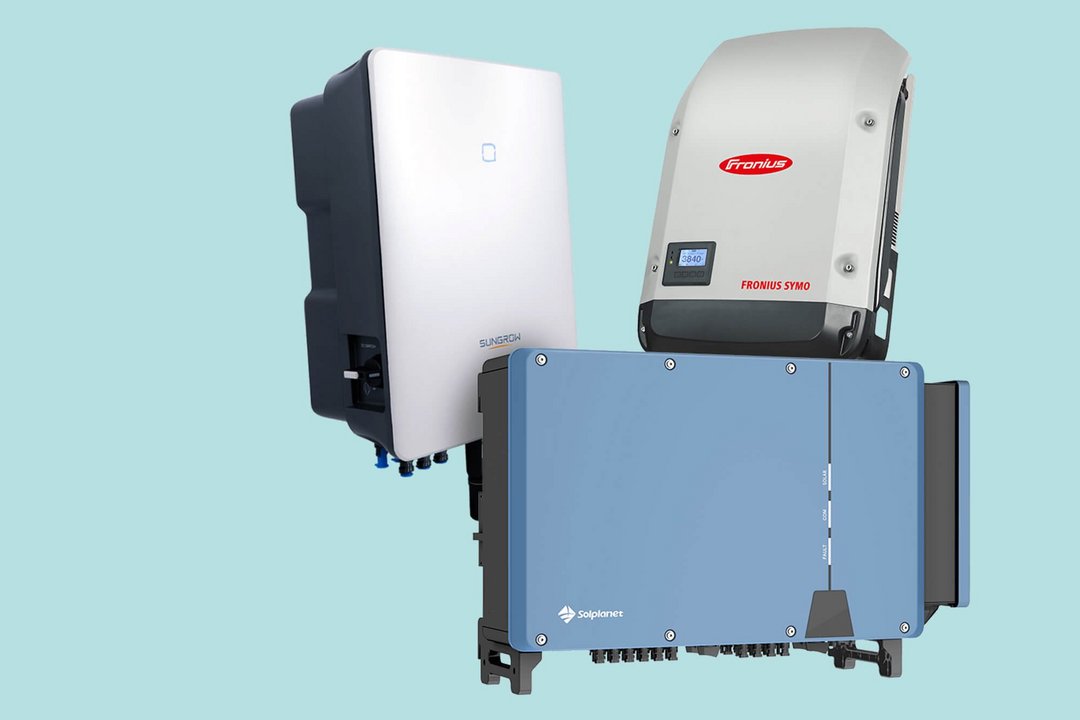Direct current becomes mains power.
The solar inverter forms the heart of the connection between solar modules and the power grid. It converts the direct current from the solar cells into grid-compatible alternating current. With an off-grid power supply, a battery inverter forms an independent power grid for all AC-powered electrical appliances, into which - depending on the model - other solar inverters can also feed. This is also the case in some backup systems. However, the solar inverter does not only function as a current converter.

The solar inverter also fulfils a whole range of other tasks:
- Monitoring and controlling the entire photovoltaic system
- Ensuring maximum performance
- Recording all operating data
- Disconnecting from the grid automatically if needed (for grid-connected systems)
- Interrupting grid feed-in
- Protecting the grid against overload
- On mains-independent backup systems, switching from mains to emergency power within milliseconds in the event of a power failure – ensuring uninterrupted power supply.
There are numerous inverters in different performance classes on the market. With the strong brands in our portfolio—including SMA, Sungrow, Fronius, Solplanet, GoodWe and Enphase — we have the right solution for every photovoltaic system.
What does a solar inverter do?
A solar inverter has the important job of converting the direct current that solar modules generate into alternating current, which makes it usable to the public power grid. This makes it an integral part of the photovoltaic system, because converting the power is what makes it possible to operate electronic devices using solar energy. Inverters have an input side (for direct current, abbreviation: DC) containing one or more DC actuators with MPP trackers, all controlled by a microprocessor. The actual conversion of the energy (into alternating current, or AC for short) takes place in the next stage, after which it is passed to the output side. From there, it is fed into the power grid. There are several different types of inverters. We’ve provided a brief explanation of each below.
Solar inverters: Models and versions
Inverters for photovoltaic systems must meet a number of requirements if they are to pay off over the long term. Modern models adjust quickly and flexibly to the amount of solar power generated, e.g., to shifting weather or cloud coverage. A good solar inverter will offer maximum efficiency on both high and low input voltages. As such, different inverters have different properties depending on the size and location of the photovoltaic system. No matter what, the inverter should always be tailored professionally and precisely to the photovoltaic system.
Micro inverters
This type of solar inverter is connected directly to the corresponding solar module. In other words, each solar module has its own inverter. Micro inverters are mainly used with small solar plants or in setups involving modules with different orientations.
String inverters
As the name suggests, this setup involves 'stringing' several solar modules together. So string inverters are used to connect a whole series of photovoltaic modules to the public power grid. This setup has become very popular because it can be used in a wide range of applications and offers good value for money. String inverters are suitable for both small household systems and large open-area systems.
Battery inverters
Battery inverters allow solar plants to be combined with a storage system; they intelligently control the charging and discharging of the solar battery.
Hybrid inverters
Hybrid inverters, a combination photovoltaic and battery inverters are currently the talk of the town. They combine two units into one, saving space and costs. Many of them also offer an emergency power option.
Solar inverters and MPP tracking
When you’re searching for a powerful solar inverter, you’re bound to come across the words “MPP tracking” eventually. The MPP, or maximum power point, is the point at which the solar module offers maximum performance. Where that point is depends on factors like solar radiation levels, temperature and the individual properties of the solar module. MPP tracking is about continuously recording the PV module’s performance and adapting to current conditions, so that the system is always producing as much energy as possible. It is regulated by a microcontroller that has a previously defined target value stored. Since MPP tracking is so important on photovoltaic systems, modern solar inverters often have more than one MPP tracker.
Solar inverters and their efficiency
Solar inverter efficiency is of central importance to photovoltaic systems. It reflects the overall system’s maximum energy conversion and has a major impact on yield—and thus on cost-effectiveness. How efficient a solar inverter is depends on a variety of factors, such as solar radiation, PV system location and site configuration. As such, any given solar inverter will not always deliver its maximum performance; in fact, the same inverter might offer very different efficiency levels from one location to another. In light of this, the “European efficiency ratio” was introduced several years ago to allow comparisons among inverters. This ratio represents the average of the efficiency levels at different partial outputs (5, 10, 20, 30, 50 and 100 percent of maximum output). Values are weighted to account for average fluctuations in European temperatures and weather.
Where are solar inverters connected?
Several factors play a role when choosing the ideal solar inverter placement. In principle, the inverter needs to be protected from wind and weather, which is why it is best to install them indoors (e.g., in the basement or the garage). There are additional specifications to keep in mind, however. Ambient temperature, for example, is an essential consideration: when energy is converted from direct to alternating current, some of it is lost to the environment in the form of heat. In rooms that are too warm, this heat may not properly dissipate into the air. Such high temperatures can reduce the service life of the device and its electrical components. Insufficient ceiling clearance or distance to other inverters can also impede heat dissipation. Prescribed minimum distances are intended to ensure safe operation of the devices. Another factor to consider is the level of noise generated during transformation. Although modern solar inverters generally operate very quietly, humming and clicking sounds may occur during high-capacity periods. As such, it is advisable to avoid placing the device in the immediate vicinity of living areas. Last but not least: The distance to the feed-in meter is especially important on string inverters. In principle, inverters should only be installed by qualified experts.

